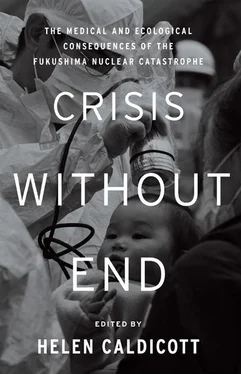3
Another Unsurprising Surprise
David Lochbaum
The disaster at Fukushima Daiichi was triggered by a series of foreseeable hazards. The disaster began with an earthquake measuring 9.0 on the Richter scale, which should have come neither as a challenge nor as a surprise. The Fukushima Daiichi plant had been designed for severe accidents, and available evidence suggests that all safety systems survived the shaking and were cooling the reactor core as intended. The earthquake, however, extensively damaged the electric power grid, which the plant needed to power the pumps, the motors, the dampers, the lights, and everything it needed to cool the reactor cores.
It had long been known that the grid was not protected against earthquakes even smaller than 9.0. Forecasting that the grid could fail, workers had installed more than a dozen diesel generators. One diesel generator for each unit was all that was needed to cool the safety systems to prevent reactor core damage. The remaining generators provided backup safety. When the earthquake took away the normal power supply, these emergency diesel generators started automatically, providing power to the equipment needed to cool the reactor cores.
The earthquake, however, also generated a tsunami, which arrived about forty-five minutes later. Forecasting that one day the ocean-side plant might experience a tsunami, the workers had installed a protective seawall around the plant that was nearly fifteen feet tall. Unfortunately, the tsunami that day was nearly forty-five feet tall. Years earlier, researchers in Japan had forecast that the site might be struck by a tsunami close to forty-six feet tall, but the plant’s owner and the regulator dismissed this on the grounds that it was overly speculative. No changes were made to the Fukushima seawall. Moreover, the diesel generators for the three reactors operating at the time of the quake were located in the basements of the turbine buildings, which were closest to the waterfront. This placement afforded the greatest protection against the earthquake but the least against flooding. The tsunami, scarcely impeded by the short seawall, inundated the site and flowed into the turbine buildings through open doorways and ventilation system louvers. The diesel generators stopped running as they were submerged in water. The company had put all of its eggs in one soggy basket.
Forecasting that the power grid might be lost and the diesel generators might fail, workers had installed banks of batteries with sufficient capacity to power one safety system for up to eight hours. Some of these were also disabled by the floodwaters, and in any case, the plant was without power for nine days. Forecasting that multiple safety systems might be required, workers had developed backups to the backups, including using diesel-powered pumps on fire trucks and barges to provide cooling water to the reactor cores. But the pressure inside the reactor vessels was nearly four times greater than the water pressure developed by the pumps. In other words, these pumps could not supply makeup water unless the reactor vessel pressure was reduced. Forecasting that it might become necessary to lower the pressure inside the reactor vessel, workers had installed valves that could vent the reactor vessel into the containment building and vent the containment building to the atmosphere, but these valves needed electrical power to work.
Meanwhile, in a cruel irony, the three reactors that were sitting a stone’s throw away from the Pacific Ocean faced meltdown due to lack of water to cool them. Forecasting that the reactor cores might overheat and melt down, producing a large amount of hydrogen as the fuel melted, workers had installed systems to purge the air inside the containment building of hydrogen. Even before the plant started up, systems were installed to replace the containment air with nitrogen. The hydrogen released from a damaged quarry reactor core would then mix with the nitrogen. With no oxygen, it could not explode. The accident, however, caused the pressure inside the containment building to rise so high that it forced the hydrogen into the surrounding reactor building, where there was no nitrogen. There were instruments inside the containment building that allowed workers to monitor the amount of hydrogen and the amount of oxygen there, and to vent the containment building when it became necessary. There were, however, no instruments inside the reactor building to monitor hydrogen and oxygen concentrations. Hydrogen gas escaped from the containment buildings into the surrounding reactor buildings, and the result was explosions at three of the reactor buildings.
With all these forecasts, the only surprising thing about Fukushima is that no steps were taken to manage the hazards. The warning signs had been there for many years prior to that disaster.
The three reactor meltdowns forced tens of thousands of people to evacuate their homes, and they are not going back any time soon. The Japan Center for Economic Research recently estimated that the cost of the Fukushima disaster was somewhere between $71 billion and $250 billion. This includes $54 billion to buy the contaminated land from people who had to leave their homes within twenty kilometers of Fukushima Daiichi, and $8 billion in order to compensate the former residents. Even if the actual price tag ends up being on the low end of this $71 billion to $250 billion range, that cost far exceeds the expense of what would have been prudent safety investments years ago.
Had the electrical grid been fortified to withstand an earthquake, the continued availability of electric power would have prevented this disaster. There would have been electrical supplies so that the workers could use the equipment that was already there. Had the seawall been raised to a height taller than a tsunami, the safety equipment would not have been flooded and the combined availability of the normal power supply, the backup power supply, and the backup to the backup power supplies would have prevented this disaster. Had the diesel generators and associated electrical buses been located at various elevations and had there been air-cooled generators that did not require cooling water, the availability of some of this equipment would have prevented this disaster. Had the battery banks been installed such that some of them would have survived the tsunami and the rest of them would have lasted more than eight hours, the disaster would have been averted. Had the Fukushima reactor been equipped with a means to reduce the pressure inside the reactor vessel in the containment so that the diesel-driven fire pumps could have worked, the disaster would have been averted. Had workers been given a viable plan when all those things failed, the disaster would have been averted.
The cost of all of these measures would likely have exceeded $71 billion, but it would not have been necessary to pay for all of them, or even the most expensive of them. All they would have had to do was pay for one of those upgrades, even the cheapest one. Doing nothing against a known hazard is irresponsible, and people should be jailed for those decisions.
All the hazards that factored into Fukushima’s tragedy had been predicted many years earlier. Nuclear power plants can be built and can operate successfully. Severe accidents like Fukushima continue to occur because nuclear plant owners continue to pretend that they cannot happen. We can struggle against unknown hazards but we have no excuse for operating plants vulnerable to known hazards. We have the capability to protect against these hazards, and we only need to match our capability with the will to do so. When researchers concluded that Fukushima might experience a tsunami higher than its seawall, it should have led the nuclear plant owners and the regulators to evaluate the need to build a taller seawall and relocate emergency diesel generators, providing a reliable backup. The battery power was designed only to last for eight hours, so somebody should have raised the question of what would happen in the ninth hour. If the answer was “Go back to the drawing board and hope for a miracle,” that is the wrong answer. Plant owners and regulators can set lower protective standards than a known hazard as long as there is something other than a miracle to step in to save the day. No one asked the right questions and we are paying a high price for that.
Читать дальше












![Helen Rowland - The Widow [To Say Nothing of the Man]](/books/752764/helen-rowland-the-widow-to-say-nothing-of-the-man-thumb.webp)